Wearable Injectors Market Size and Share
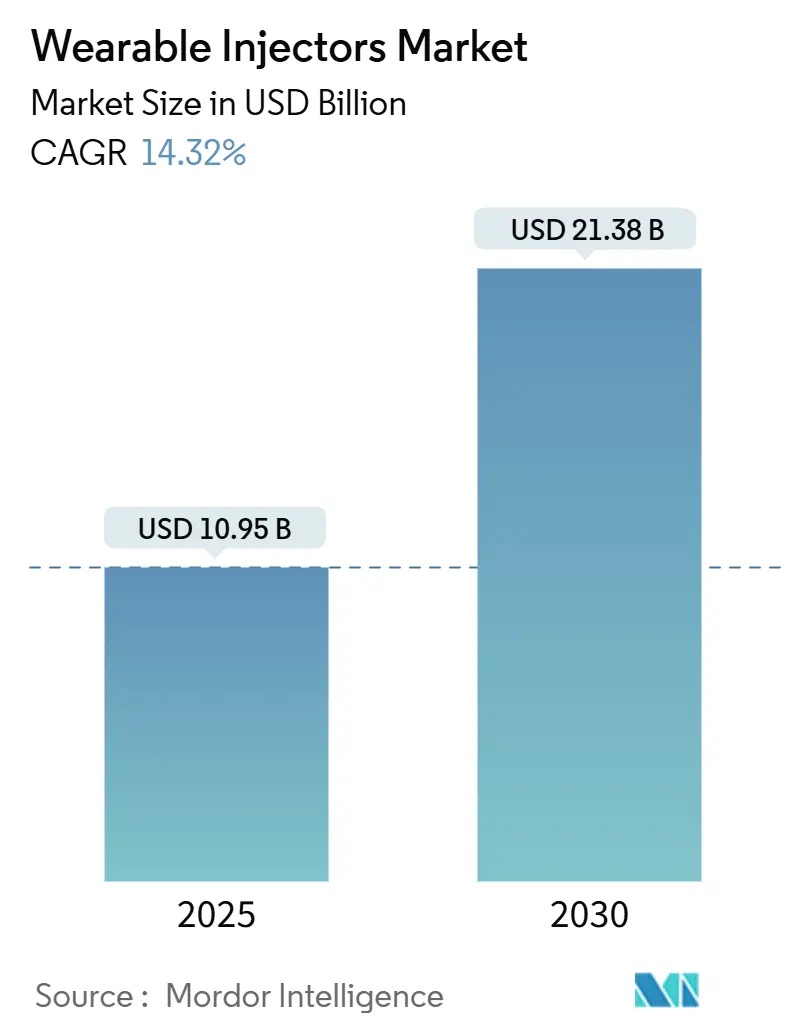
Wearable Injectors Market Analysis by Mordor Intelligence
The Wearable Injectors Market size is estimated at USD 10.95 billion in 2025, and is expected to reach USD 21.38 billion by 2030, at a CAGR of 14.32% during the forecast period (2025-2030).
The surge is anchored in rising biologics approvals, an expanding global chronic-disease population, and the healthcare sector’s pivot to patient-centric, home-based care models. Device makers are prioritizing connected platforms, high-viscosity capability, and user-friendly designs to support self-administration trends. Pharmaceutical companies leverage these devices to improve adherence, shorten infusion times, and lower hospital utilization, while payers increasingly reimburse for home infusion to curb care costs. Competitive intensity is set by established med-tech firms partnering with drug manufacturers, yet supply-chain constraints in specialty polymers and battery-life sustainability challenge near-term scaling.
Key Report Takeaways
- By product type, on-body patch injectors led with 61.62% of wearable injectors market share in 2024; smart injectors are forecast to expand at a 15.93% CAGR through 2030.
- By therapy area, oncology accounted for 33.76% of the wearable injectors market size in 2024, while rare and orphan diseases are projected to grow at 17.60% CAGR to 2030.
- By end user, home-care settings captured 48.34% revenue in 2024; specialty infusion centers are poised for the fastest growth at 14.72% CAGR through 2030.
- By geography, North America commanded 43.21% share of the wearable injectors market in 2024; Asia-Pacific is set to register the highest CAGR of 15.08% between 2025-2030.
Global Wearable Injectors Market Trends and Insights
Drivers Impact Analysis
| Driver | (~) % Impact on CAGR Forecast | Geographic Relevance | Impact Timeline |
|---|---|---|---|
| Growing Prevalence of Chronic Diseases | +3.2% | Global, with highest impact in North America and Europe | Long term (≥ 4 years) |
| Technological Advancements in Wearable Injector Platforms | +2.8% | North America & EU leading, APAC adoption accelerating | Medium term (2-4 years) |
| Shift Toward Home-Based Treatment & Self-Administration | +2.5% | Global, particularly strong in developed markets | Medium term (2-4 years) |
| Rising Pipeline of Biologics & Large-Molecule Drugs | +2.1% | Global, with concentration in US and European markets | Long term (≥ 4 years) |
| Micro-MEMS Enabling High-Viscosity Formulation Delivery | +1.8% | Global, led by technology hubs in US, Germany, Japan | Long term (≥ 4 years) |
| Payer Adoption of Digital Adherence Analytics | +1.4% | North America & EU, gradual APAC penetration | Medium term (2-4 years) |
| Source: Mordor Intelligence | |||
Growing Prevalence of Chronic Diseases
Diabetes affected 536.6 million adults worldwide in 2021 and is projected to reach 783.2 million by 2045, underpinning sustained demand for automated delivery systems that can manage polypharmacy outside hospital settings. Multi-morbidity affects 27.1% of US adults, up from 21.8% a decade earlier, amplifying the need for connected injectors that track complex dosing schedules.[1]Centers for Disease Control and Prevention, “National Center for Chronic Disease Prevention Data,” cdc.gov These trends position the wearable injectors market as a critical enabler of chronic disease management by reducing clinic visits, improving adherence, and elevating patient quality of life.
Technological Advancements in Wearable Injector Platforms
Micro-MEMS innovations now push high-viscosity biologics above 15 cP through slender cannulas, enabling on-body systems to deliver 10 mL volumes without patient discomfort. Real-time connectivity, automatic needle retraction, and IoT analytics refine dosing accuracy and generate adherence data for payers and clinicians. FDA draft guidance on essential drug-delivery outputs establishes performance benchmarks that accelerate device clearances.[2]U.S. Food & Drug Administration, “Draft Guidance for Industry: Essential Performance Requirements for Combination Products,” fda.gov Piezoelectric micropumps attaining 4 mL/min flow at 35.7 kPa further illustrate the precision gains that are reshaping the wearable injectors market.
Shift Toward Home-Based Treatment & Self-Administration
The FDA’s 2025 approval of Onapgo, a wearable subcutaneous infusion device for advanced Parkinson’s disease, validated complex therapies in home settings by reducing OFF-time markedly versus placebo. Payer surveys reveal 90% consider wearable injectors address unmet needs and 82% would reimburse premiums for their use. Virtual-reality and smartphone tutorials now streamline patient training, making self-management feasible for broader demographics.
Rising Pipeline of Biologics & Large-Molecule Drugs
Biologics comprised a rising share of the record 71 US FDA drug approvals in 2023, magnifying demand for large-volume subcutaneous delivery platforms.[3]Nature Biotechnology Editors, “New Drug Approvals 2023,” nature.com On-body solutions such as Stevanato Group’s Vertiva 10 mL system tailor flow rates and needle lengths to match therapy profiles. Subcutaneous amivantamab, administered in under five minutes, illustrates how wearable platforms shrink infusion windows from hours to minutes, enhancing patient convenience.
Restraints Impact Analysis
| Restraint | (~) % Impact on CAGR Forecast | Geographic Relevance | Impact Timeline |
|---|---|---|---|
| Preference for Alternative Drug-Delivery Modes | -1.8% | Global, stronger in traditional healthcare systems | Medium term (2-4 years) |
| Unfavorable Reimbursement in Developing Nations | -1.5% | APAC, Latin America, Africa | Long term (≥ 4 years) |
| Battery-Life & E-Waste Disposal Concerns | -1.2% | Global, heightened in environmentally conscious markets | Short term (≤ 2 years) |
| Shortage of Specialty Polymers for Injector Housings | -0.9% | Global supply chain impact, concentrated in manufacturing hubs | Short term (≤ 2 years) |
| Source: Mordor Intelligence | |||
Preference for Alternative Drug-Delivery Modes
Hospital infusion centers still rely on traditional IV workflows that generate billable events, slowing transition to wearable injectors. Needle-free technologies such as InsuJet attract patients wary of self-injection, while oral biologic capsules from Rani Therapeutics could eventually bypass device-based delivery. These alternatives anchor provider inertia and temper the near-term growth of the wearable injectors market.
Unfavorable Reimbursement in Developing Nations
Medical devices account for only 3-6% of total healthcare spending across many Asia-Pacific economies, limiting funding for single-use wearables. Bundled payments often exclude separate reimbursement for injectors, raising out-of-pocket costs that deter adoption. Fragmented procurement channels and low digital readiness further dilute the perceived value of connected injector features.
Segment Analysis
By Product Type: Smart Injectors Drive Innovation
Smart devices recorded the fastest 15.93% CAGR, buoyed by integrated sensors and mobile apps that furnish real-time adherence data to clinicians and payers. On-body patches remained dominant, controlling 61.62% of the wearable injectors market share in 2024, underpinned by entrenched use in diabetes therapy. High-volume injectors, often exceeding 5 mL, address bariatric biologics and cancer therapeutics, while off-body belt formats fill niche needs requiring prolonged wear and large reservoirs.
BD’s alliance with Ypsomed couples glass prefillable syringes with high-viscosity autoinjectors to deliver biologics over 15 cP viscosity, an advance aligning with pharma’s pipeline of dense formulations. Artificial-intelligence algorithms embedded in next-generation smart injectors personalize dosing intervals by analyzing glucose or biomarker feedback, improving outcomes, and cementing customer loyalty to specific device ecosystems.
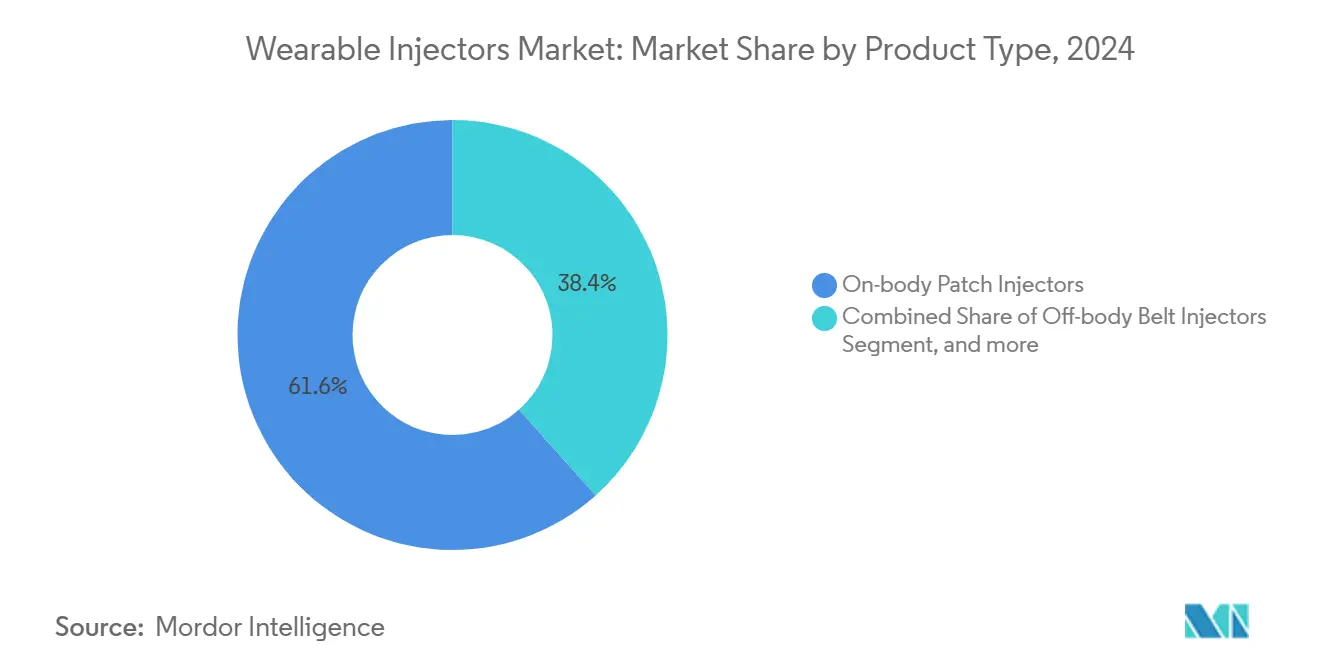
Note: Segment shares of all individual segments available upon report purchase
By Therapy Area: Oncology Dominance Amid Rare-Disease Upside
Oncology commanded 33.76% of the wearable injectors market size in 2024 as subcutaneous monoclonal antibodies shorten chair time and release infusion suite capacity. Phase 3 data confirmed non-inferior outcomes for subcutaneous amivantamab with administration time cut to under five minutes, highlighting patient benefit.
Rare-disease therapies, though smaller in absolute volume, are poised for a 17.60% CAGR through 2030, as orphan-drug incentives spur biologic launches requiring precise, home-friendly delivery. The ability to schedule large-volume injections every three weeks empowers on-body systems to complement or replace intermittent clinic infusions, minimizing patient fatigue and transport costs.
By End User: Home-Care Settings Lead Transformation
Home care retained 48.34% revenue share in 2024, reflecting payer and patient endorsement of self-treatment that cuts facility overhead and infection risk. Specialty infusion centers, growing at 14.72% CAGR, function as transitional hubs that initiate therapy before shifting patients to home-based regimens. Hospitals remain crucial launch sites for high-risk oncology and immunology products that need first-dose monitoring.
Usability studies on on-body infusors logged 99.2% successful task completion across patients, caregivers, and clinicians, supporting the safety of decentralized models. FDA clearance of Enable Injections’ enFuse for pegcetacoplan further validates the migration of large-volume therapies into home settings, with 60% uptake among eligible patients within four months.
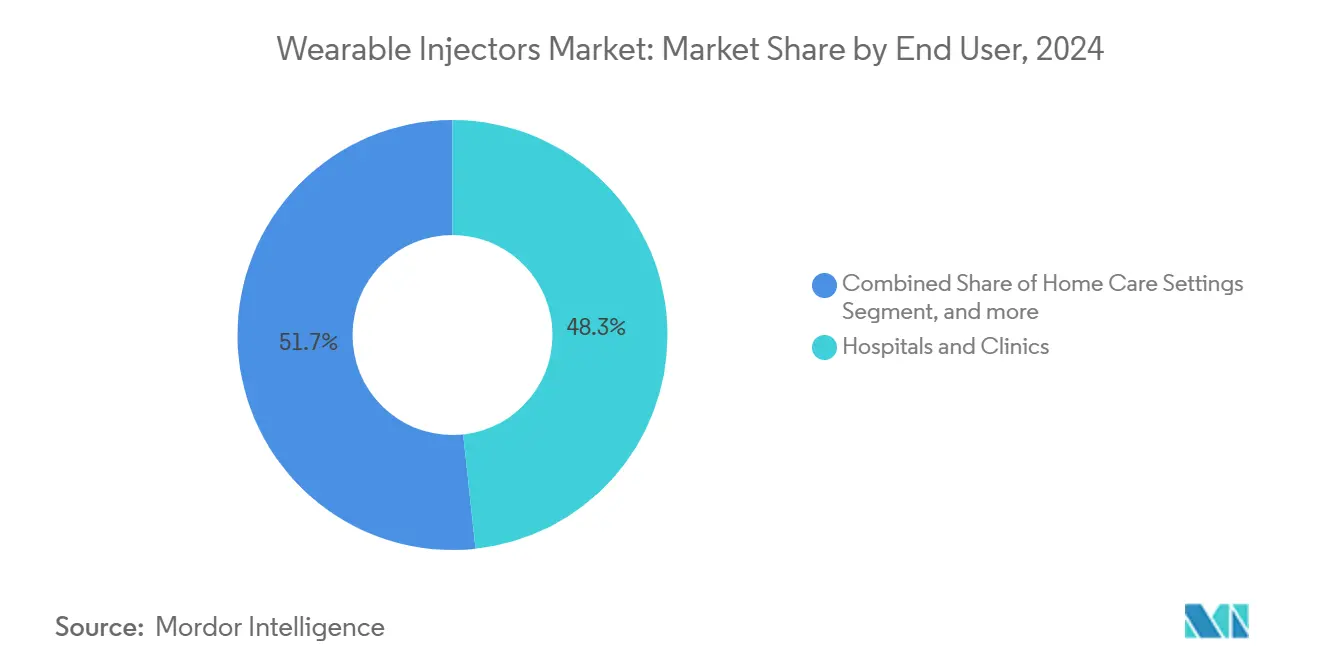
Note: Segment shares of all individual segments available upon report purchase
Geography Analysis
North America captured 43.21% of the wearable injectors market in 2024, undergirded by clear FDA regulatory pathways, entrenched healthcare connectivity, and a high burden of chronic disease. Insulet’s Omnipod platform alone exceeded 500,000 active users after posting 22% revenue growth in 2024, illustrating robust device adoption. Most payers now reimburse connected injectors that transmit adherence data into electronic health records, aligning incentives for self-administration.
Asia-Pacific is projected to register the swiftest 15.08% CAGR through 2030, propelled by middle-class expansion, government digital-health policies, and rising biologic launches. China and Japan spearhead volume demand and regulatory modernization, while India, Indonesia, and Thailand show accelerating uptake owing to chronic-disease prevalence and mobile-health penetration. Fragmented reimbursement and lower device-spending ratios, however, temper immediate scale-up.
Europe benefits from harmonized medical-device regulations that streamline cross-border approvals, ensuring predictable adoption in Germany, France, and the United Kingdom. National health systems emphasize patient-centric chronic-care pathways that incorporate connected injectors into integrated disease-management programs. Latin America and the Middle East & Africa hold latent potential but remain inhibited by infrastructure deficits and limited payer coverage, steering vendors toward tiered-pricing and public-private-partnership models to seed early demand.
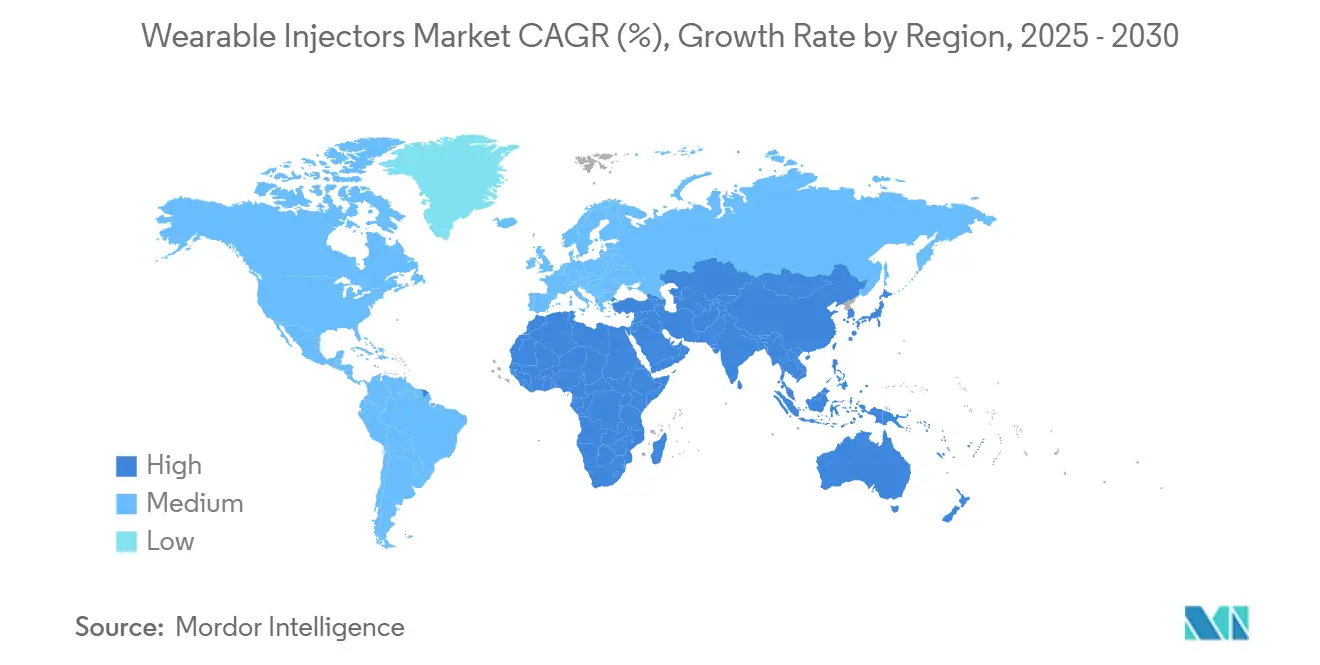
Competitive Landscape
The wearable injectors market is moderately consolidated, with several large global companies holding significant shares. Conglomerates and specialized medical device companies dominate the market, focusing on innovation and product development. Major players in the wearable injectors market include Becton, Dickinson and Company, Insulet Corporation, Ypsomed, Tandem Diabetes Care, Inc., and Amgen. These companies are recognized for their strong R&D capabilities, driving product innovation and expanding market presence.
Connectivity, dosing precision, and patient comfort rather than basic injection mechanics define differentiation. FDA classification of on-body injectors as Class II devices under CFR 880.5 affords a clear review pathway, inviting newcomers who can satisfy human-factor and sterility mandates. Needle-free and oral biologic platforms loom as disruptive forces, compelling incumbents to incorporate AI-driven adherence analytics, sustainable power systems, and recyclable housings to sustain advantage. Supply-chain strain in specialty polymers and lithium cells places a premium on dual-sourcing strategies and circular-economy design.
Developers increasingly bundle wrap-around digital services ranging from virtual training to cloud dashboards to lock in customers and create data assets useful for post-market surveillance and value-based contracting. As biologic volumes rise, partnerships between device firms and CDMOs (contract development and manufacturing organizations) intensify, integrating primary-container expertise with electronic and mechanical subsystems to deliver turnkey solutions for pharmaceutical clients.
Wearable Injectors Industry Leaders
-
Becton, Dickinson and Company
-
Insulet Corporation
-
Ypsomed
-
Tandem Diabetes Care, Inc.
-
Amgen
- *Disclaimer: Major Players sorted in no particular order
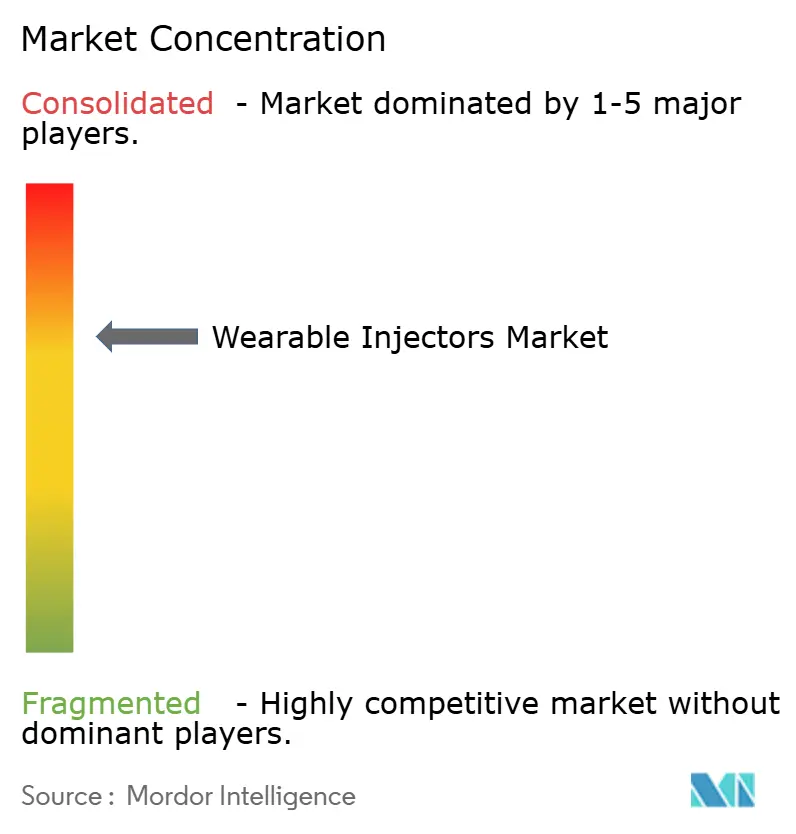
Recent Industry Developments
- March 2025: Stevanato Group reported record revenue of EUR 1,104 million (USD 1,193 million) for fiscal year 2024, with high-value solutions representing 38% of total revenue driven by strong biologics demand and expanded manufacturing capacity for pre-filled syringes and cartridges.
- February 2025: Tandem Diabetes Care announced record Q4 2024 sales of USD 282.6 million with 44% GAAP growth, driven by 25% increase in pump shipments and double-digit conversions from multiple daily injections, while receiving FDA clearance for Control-IQ+ technology for type 2 diabetes.
- February 2025: FDA approved Onapgo (apomorphine hydrochloride) as the first wearable subcutaneous infusion device for treating motor fluctuations in advanced Parkinson disease, demonstrating significant reduction in daily OFF time and increased GOOD ON time in phase 3 trials.
- April 2024: Ypsomed partnered with ten23 Health, a globally recognized Swiss contract development and manufacturing organization. This collaboration aims to propel the commercialization of the YpsoDose wearable injector, designed for subcutaneous self-injection of large-volume doses.
Research Methodology Framework and Report Scope
Market Definitions and Key Coverage
Our study defines the wearable injectors market as the global revenue generated from on-body and off-body, single-use or reusable devices that autonomously deliver ≥2 mL of prescription medicines subcutaneously over minutes to hours while the patient carries on normal activity. Therapeutic scope spans oncology, metabolic, autoimmune, cardiovascular, infectious, and rare diseases wherever large-volume biologics or high-viscosity formulations are deployed.
Scope exclusion: insulin-only tubed pumps and conventional spring-loaded auto-injector pens are not counted.
Segmentation Overview
- By Product Type
- On-body Patch Injectors
- Off-body Belt Injectors
- Smart Injectors
- High-volume (≥5 mL) Injectors
- By Therapy Area
- Oncology
- Autoimmune Disorders
- Diabetes
- Cardiovascular Diseases
- Rare & Orphan Diseases
- By End User
- Hospitals & Clinics
- Home Care Settings
- Specialty Infusion Centers
- By Geography
- North America
- United States
- Canada
- Mexico
- Europe
- Germany
- United Kingdom
- France
- Italy
- Spain
- Rest of Europe
- Asia-Pacific
- China
- Japan
- India
- Australia
- South Korea
- Rest of Asia-Pacific
- Middle East & Africa
- GCC
- South Africa
- Rest of Middle East & Africa
- South America
- Brazil
- Argentina
- Rest of South America
- North America
Detailed Research Methodology and Data Validation
Primary Research
Mordor analysts interviewed device engineers, contract manufacturers, hospital pharmacists, and reimbursement specialists across North America, Europe, and Asia to vet ASP progressions, failure-rate assumptions, and adoption curves in home-care pathways. Structured questionnaires and follow-up calls filled data gaps around fill-finish capacity, biologic pipeline viscosity profiles, and regional regulatory lag.
Desk Research
We began with publicly available sources such as US FDA 510(k)/Combination Product clearances, EMA device guidance, the International Diabetes Federation Atlas, WHO cancer burden files, and national health-expenditure datasets. Trade-body portals, including the Alliance to Advance Medical Device Excellence and the Pharmaceutical Research and Manufacturers of America, provided shipment trends and pipeline volumes. Company 10-Ks, investor decks, patent analytics from Questel, and shipment tallies from Volza refined baseline volumes and average selling prices (ASPs).
Supplementary insight was drawn from D&B Hoovers financials, Dow Jones Factiva news flow, and peer-reviewed journals that quantified dose volumes tolerated per anatomical site. The sources cited above illustrate, rather than exhaust, the secondary corpus consulted.
Market-Sizing & Forecasting
A top-down model converts chronic-disease prevalence into target-treated cohorts, applies therapy penetration rates, and multiplies by annual dose requirements to yield drug-delivery demand pools. Select bottom-up checks, supplier roll-ups and sampled ASP × volume audits, calibrate totals before finalization. Key variables include biologic approvals per year, average delivered volume per dose, device discard frequency, share of disposable formats, and payer incentives for home administration. Multivariate regression with scenario analysis projects revenue through 2030, with sensitivity ranges around biologic-pipeline success rates and ASP compression.
Data Validation & Update Cycle
Outputs pass multi-analyst peer review, variance screening against independent shipment tallies, and anomaly flags. Models refresh annually; interim updates trigger when material events, major recalls, blockbuster approvals, or reimbursement shifts, occur.
Why Mordor's Wearable Injectors Baseline Commands Reliability
Published estimates diverge widely because firms choose different device families, pricing ladders, and refresh cadences.
Key gap drivers include scope, some analysts exclude programmable reusable platforms, currency-conversion timing, and whether insulin pump revenues are folded in, which inflates totals elsewhere.
Benchmark comparison
| Market Size | Anonymized source | Primary gap driver |
|---|---|---|
| USD 10.95 B | Mordor Intelligence | - |
| USD 11.33 B | Global Consultancy A | Includes insulin patch pumps and applies single 2024 ASP for forecast years |
| USD 10.12 B (2024) | Industry Journal B | Lacks primary interviews; extrapolates 2023 hospital-purchase prices without home-care discounting |
These comparisons show that when consistent scope, mixed-method validation, and yearly refresh are applied, Mordor delivers a balanced, transparent baseline that decision-makers can replicate and trust.
Key Questions Answered in the Report
What is the current wearable injectors market size?
The wearable injectors market size reached USD 10.95 billion in 2025 and is projected to hit USD 21.38 billion by 2030 at a 14.32% CAGR.
Which segment holds the largest share of the wearable injectors market?
On-body patch injectors led with 61.62% of the wearable injectors market share in 2024, primarily due to widespread adoption in diabetes management.
Which region is expected to grow fastest in the wearable injectors market?
Asia-Pacific is forecast to post the quickest 15.08% CAGR through 2030, supported by healthcare digitization policies and expanding middle-class populations.
What therapeutic area dominates wearable injector use?
Oncology applications accounted for 33.76% of the wearable injectors market size in 2024, with subcutaneous biologics reducing infusion times for cancer patients.
How are payers influencing the adoption of wearable injectors?
Surveys show 90% of payers believe wearable injectors address unmet care needs, and 82% are willing to pay a premium for devices that enable safe home-based treatment.
What sustainability challenges face the wearable injectors industry?
Battery end-of-life management and polymer waste pose environmental concerns, prompting manufacturers to explore recyclable housings and longer-life power solutions.
Page last updated on:


